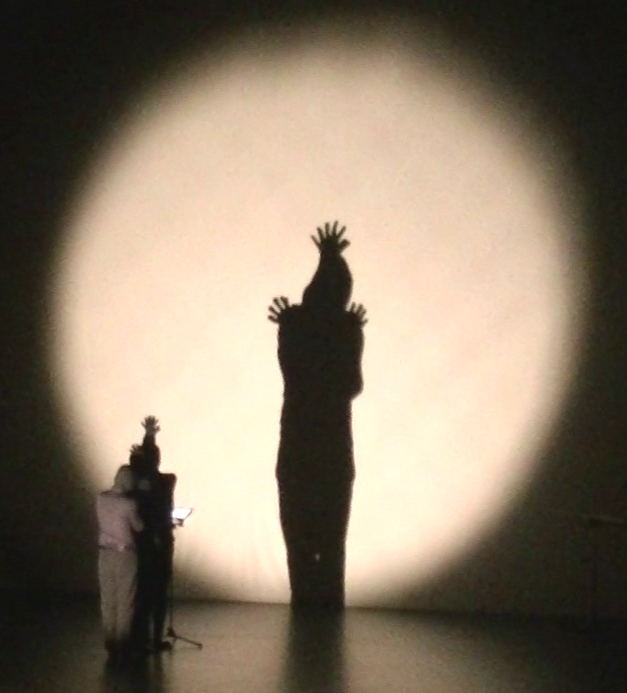shadow music (2016)
Bass Clarinet, Alto Saxophone, Piano, Drumset, Electric guitar, 3 shadow players
variable duration (min. 17′)
WP Feb. 2016, Theaterhaus Stuttgart, Festival ATTACCA, SWR
ensemble suono mobile, dir: Christof M. Löser
Edition Juliane Klein Order No.: EJK0806
Score Preview (Publisher, pdf)

A research into shadow theater led me to Thai “shadow music”. This term refers to a musical genre that emerged in the early 1960s and combines elements of predominantly instrumental West Coast surf rock with traditional Thai melodies, timbres and forms. Its origins are closely linked to the American soldiers who visited the Land of Smiles as tourists on their days off during the Vietnam War and were offered an entertainment program. This makes “Shadow Music” or “wong shadow” a sounding symptom of America’s influence on Thai culture through a policy that supported the monarchy at the time in order to create a counterpoint to the communist regimes of neighbouring countries. At the same time, however, it is also an expression of an emancipatory process in which the musicians actively appropriate and transform American music due to and despite the political conditions and perform it with dedication and high energy.
I take this attitude as a model and try to appropriate the music by rewriting it: on the one hand piphat, the ceremonial music of Thailand, and on the other hand surf music.
Piphat is characterized by a long, repetitive melody consisting of several phrases of varying duration and a regular pulse with few syncopations, which is increasingly accelerated in the course of the circular repetitions. The melody is played heterophonically by several instruments and the pulse is played sparingly with drums or cymbals.
Surf rock is characterized by the powerful, reverb-soaked guitar sound with expressive use of the vibrato lever. Surf music usually has a 32-bar form scheme in 4/4 time and a virtuoso drum set that articulates the constant, fast tempos.
Such characteristics contradict the irregular phrasing in the horizontal course of piphat music. This contradiction can be heard in “Wong Shadow”. It is conflict-laden music that attempts to combine tradition and ritual with a capitalist understanding of democracy.
The contradictory musical structures in my composition are not connected vertically as in “Wong Shadow”, but are notated in different layers. Each layer represents a different degree of distance/proximity to the sources mentioned. While a click-track as sole ruler beats the 4/4 beat of the surf music and combines it with gradual accelerandi derived from the piphat, there are shadow conductors also at work. The shadow theater determines which layer each instrument has to play and when it has to be silent. The musicians, guided by the click, form-influencing shadows and musical text, are confronted with a high degree of domination. If one of them decides to step out of line, they must bear the consequences.
Annesley Black, Sept.2016
(DEUTSCH)
Eine Forschungsreise hat mich vom Schattentheater hin zur thailändischen “Shadow Music” geführt. Mit diesem Begriff wird ein Musikgenre bezeichnet, das in den frühen 60er Jahren entstand und Elemente des vorwiegend instrumentalen Westcoast Surf Rocks mit traditionellen thailandischen Melodien, Klangfarben und Formen kombiniert. Ihre Entstehung ist eng mit den amerikanischen Soldaten verbunden, die während des Vietnamkrieges als Touristen in ihren freien Tagen das Land des Lächelns besuchten und ein Unterhaltungsprogramm angeboten bekommen sollten. Damit ist “Shadow Music” oder “wong shadow” klingendes Symptom der Einflussnahme
Amerikas auf die thailändische Kultur durch eine Politik, die zu diesem Zeitpunkt die Monarchie unterstützte, um einen Gegenpol zu den kommunistischen Regimen der Nachbarländer zu erzeugen. Gleichermaßen ist sie aber auch
Ausdruck eines emanzipatorischen Prozesses, in dem die Musiker aufgrund und trotz der politischen Bedingungen aktiv die amerikanische Musik sich aneignen, umformen und mit Hingabe und hoher Energie zur Aufführung bringen.
Ich nehme die mir diese Haltung zum Vorbild und versuche mir die Musik anzueignen, in dem ich sie ab- und damit umschreibe: zum einen Piphat, die zeremonielle Musik Thailands, zum anderen die Surfmusik.
Charakteristische Merkmale von Piphat sind eine lange, sich wiederholende Melodie, die aus mehreren Phrasen unterschiedlicher Dauer besteht und ein regelmäßiger Puls mit wenigen Synkopen, der im Verlauf der in sich kreisenden Wiederholungen zunehmend beschleunigt wird. Die Melodie wird heterophonisch von mehreren Instrumenten gespielt und der Puls sparsam mit Trommeln oder Zimbeln wiedergegeben.
Kennzeichend für den Surf Rock ist der schlagkräftige, mit Reverb durchtränkte Gitarrenklang bei expressivem Einsatz des Vibratohebels. Surfmusik besitzt in der Regel ein 32-taktiges Formschema im 4/4 Takt und eine virtuos geführtes Drumset, welches die gleichbleibenden, schnellen Tempi artikuliert.
Solche Eigenschaften widersprechen den unregelmäßigen Phrasierungen im horizontalen Verlauf der Piphat Musik.
Dieser Widerspruch ist in “Wong Shadow” zu hören. Es ist eine konfliktreiche Musik, die den Versuch unternimmt, Tradition und Ritus mit einem kapitalistisch geprägten Demokratieverständnis zu verbinden.
Die sich widersprechenden musikalischen Strukturen sind in meiner Komposition nicht vertikal verbunden wie im “Wong Shadow”, sondern in verschiedenen Schichten notiert. Jede Schicht vertritt dabei einen anderen Grad von Entfernung/Nähe zu den genannten Quellen. Während ein Dirigent als Alleinherrscher den 4/4 Takt der Surfmusik schlägt und mit allmählichen, aus dem Piphat abgeleiteten Accelerandi kombiniert, stehen dahinter Schattendirigenten. Das Schattentheater bestimmt, welche Schicht jedes Instrument zu spielen und wann es zu schweigen hat. Die Musiker, angeleitet durch Dirigent, formbeeinflussende Schatten und Notentext, sind in hohem Maße mit Herrschaft konfrontiert. Wenn einer von ihnen sich entscheidet, aus der Reihe zu treten, muss er die Folgen tragen.
Annesley Black, Sept 2016
Annesley Black